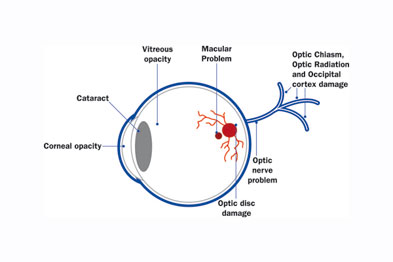Retinal Dystrophy and Alstrom Syndrome: The Overlooked Connection Damaging Your Vision
- admin
- September 23, 2024
- 6:27 pm
- No Comments

When it comes to eye health, most of us are familiar with common conditions like cataracts or glaucoma.
But what if I told you there is a rare but serious duo silently threatening vision across the globe?
Enter Retinal Dystrophy and Alstrom Syndrome – a lesser-known but devastating combination that can gradually rob individuals of their sight by damaging retinal cells.
This dynamic duo does not get the attention it deserves, despite the fact that it can significantly impact the quality of life.
In this article, we shall dive into the intricacies of these conditions, explore their interconnections, and shed light on why this connection is crucial for early diagnosis and treatment.
Contents of “Retinal Dystrophy and Alstrom Syndrome” Article:
- Understanding Retinal Dystrophy: The Basics
- Alstrom Syndrome: A Rare but Devastating Disorder
- The Overlooked Connection: Retinal Dystrophy and Alstrom Syndrome
- Recognizing Retinal Dystrophy Symptoms Early
- Common Forms of Retinal Dystrophy and Their Symptoms
- Current Approaches to Retinal Dystrophy Treatment
- Conclusion: Why Early Diagnosis is Key
Understanding Retinal Dystrophy: The Basics
Retinal dystrophy is a group of hereditary disorders affecting the retina, the light-sensitive tissue at the back of your eye responsible for converting light into visual signals.
Think of it as the film in an old-school camera; if it is damaged, the image quality is compromised. This condition can lead to progressive vision loss and, in severe cases, complete blindness.
The most common type is pigmentary retinal dystrophy, where the retina slowly degenerates, causing night blindness and tunnel vision.
The tricky part?
Retinal dystrophy is often inherited, meaning it can run in families. The genetic mutations involved affect the photoreceptor cells in the retina, causing them to deteriorate over time.
With over 200 different gene mutations linked to inherited retinal dystrophy, this is a complex and multifaceted condition that requires more awareness and research.
Alstrom Syndrome: A Rare but Devastating Disorder
Alstrom Syndrome is a rare genetic disorder that affects multiple organ systems, but one of its earliest and most debilitating symptoms is severe retinal dystrophy.
Imagine dealing not only with progressive vision loss but also with a host of other issues like hearing loss, heart problems, and metabolic disorders. It is like fighting a battle on multiple fronts.
Alstrom Syndrome is caused by mutations in the ALMS1 gene, which is essential for normal cellular function.
The condition is autosomal recessive, meaning that a person must inherit two defective copies of the gene, one from each parent, to manifest the disease.
Early signs often include sensitivity to light, involuntary eye movements, and, of course, progressive loss of vision due to retinal dystrophy.
The Overlooked Connection: Retinal Dystrophy and Alstrom Syndrome
While retinal dystrophy can exist independently, its presence in Alstrom Syndrome complicates things significantly.
In fact, retinal dystrophy symptoms often appear before other symptoms of Alstrom Syndrome, making it a critical early indicator of this complex condition.
This connection is often overlooked because healthcare providers might not immediately link vision problems to a multi-system disorder like Alstrom Syndrome.
Why is this connection crucial?
Early diagnosis of retinal dystrophy, especially in the context of Alstrom Syndrome, can lead to better management of other associated symptoms, such as obesity, diabetes both type 1 and type 2, and cardiomyopathy.
Addressing vision loss early on can significantly improve the quality of life for patients, who otherwise may suffer from a debilitating loss of vision alongside other health issues.
Recognizing Retinal Dystrophy Symptoms Early
Early detection of retinal dystrophy symptoms can make a significant difference in treatment outcomes and quality of life—especially for individuals with rare genetic disorders such as Alström Syndrome.
These inherited retinal diseases often progress silently, making timely recognition crucial for early intervention, appropriate care, and the possibility of participating in future clinical trials or gene therapy options.
Retinal dystrophies are a group of disorders that cause progressive degeneration of the retina, the light-sensitive tissue at the back of the eye.
In Alström Syndrome—a rare autosomal recessive condition—retinal degeneration is typically one of the earliest presenting features, often detectable within the first few months of life.
Common symptoms include:
Night Blindness: Difficulty seeing in dim lighting is often the earliest sign and may become noticeable when a child hesitates in dark rooms or poorly lit areas.
Tunnel Vision: Peripheral vision gradually diminishes, causing individuals to rely on a narrow central visual field, which can impact navigation and depth perception.
Photophobia: Sensitivity to bright lights is another hallmark, making outdoor activities or fluorescent lighting uncomfortable.
Loss of Central Vision: Reading, recognizing faces, or seeing fine details becomes difficult, particularly as macular involvement progresses.
In Alström Syndrome, these symptoms often emerge during infancy or early childhood. Some children also tend to lose their normal hearing powers.
Parents may observe signs such as poor visual tracking, abnormal eye movements, or delayed visual milestones. Pediatricians and ophthalmologists play a vital role in identifying these red flags and recommending genetic testing and electroretinography (ERG) to confirm a diagnosis.
Early recognition not only supports access to visual aids and educational accommodations but also allows families to connect with specialists and support networks tailored to rare genetic eye disorders.
The earlier the diagnosis, the more proactive the management.

Common Forms of Retinal Dystrophy and Their Symptoms
Retinal dystrophy is not a one-size-fits-all condition.
Here are some common forms:
- Pigmentary Retinal Dystrophy: Characterized by the build-up of pigment in the retina, leading to progressive vision loss.
- Cone-Rod Dystrophy Symptoms: Include loss of central vision, color vision defects, and difficulty adapting to low-light conditions. Cone rod dystrophy treatment options are currently limited, mainly focusing on managing symptoms.
- Stargardt’s Macular Dystrophy: This form affects the macula, leading to loss of central vision. It’s a specific type of retina dystrophy with its unique set of challenges.
- Occult Macular Dystrophy: A rare condition where macular function deteriorates without visible changes in the retina, making diagnosis challenging.
Each type has unique symptoms and progression patterns, making tailored treatment approaches essential.
Current Approaches to Retinal Dystrophy Treatment
So, what are the available options for retinal dystrophy treatment?
Unfortunately, there is no cure for most forms of retinal dystrophy, but several promising therapies are under research:
- Gene Therapy: Aims to replace or repair faulty genes responsible for hereditary retinal dystrophy.
- Retinal Implants: Devices that provide artificial vision by bypassing damaged photoreceptor cells.
- Pharmacological Treatments: Certain drugs, like those used in cone rod dystrophy treatment, can slow down the progression of the disease.
- Assistive Devices: High-tech glasses and magnifiers can help improve quality of life.
For patients with Alstrom Syndrome, managing retinal dystrophy symptoms is just one part of a comprehensive treatment plan that addresses other organ system issues.
Takeaway: Why Early Diagnosis is Key?
So, can understanding the connection between retinal dystrophy and Alstrom Syndrome really make a difference?
Absolutely.
Early diagnosis of retinal dystrophy can serve as a critical clue to the presence of Alstrom Syndrome, allowing for early intervention and better management of both vision and systemic health issues (such as poor liver functionality).
For those at risk or showing early signs of retinal dystrophy symptoms, seeking a thorough postural evaluation, including genetic testing, can provide clarity and guide treatment decisions.
While there is no definitive cure for either condition, staying informed and proactive can significantly improve quality of life.
In the battle against these overlooked but impactful conditions, knowledge truly is power.
References